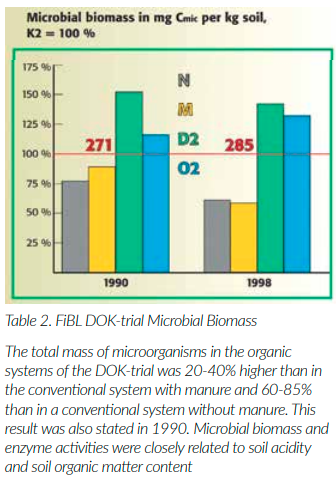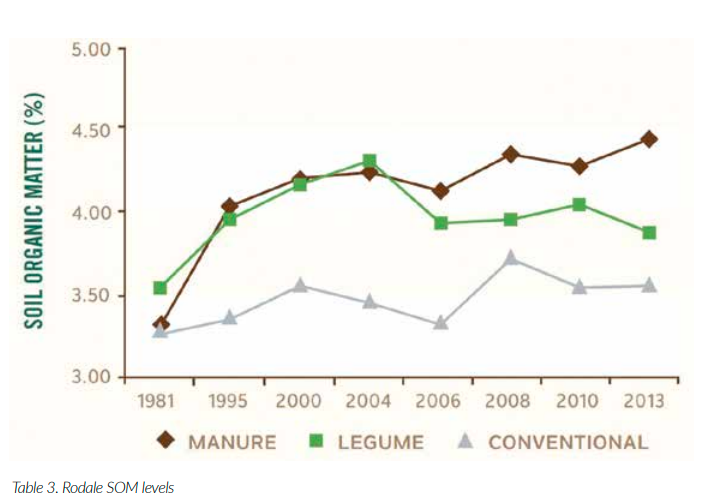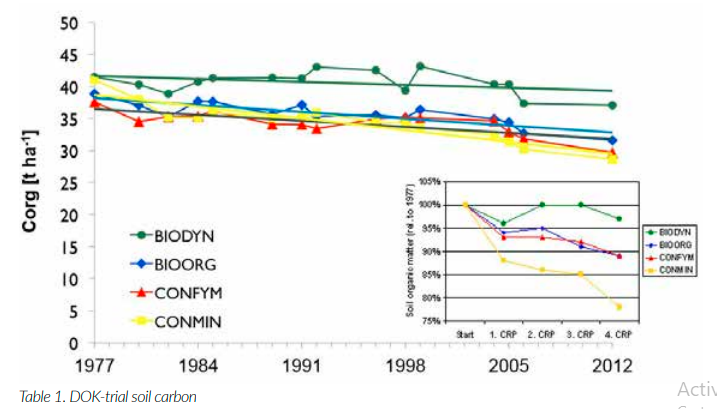Written by Mark Measures BSc. (Hons.), IOTA (Accredited), ARAgS, Churchill Fellow 2017 of the Organic Research Centre,
first Published July 2018
SOM is important and that poor rotations and lack of organic matter inputs might be something to do with their poor soil structure and static or declining yields. Organic farmers have always believed that SOM is important, not just for soil structure but also for mineralisation, which results in nitrogen release, needed for crop growth and they have in the back of their minds the idea that SOM has something to do with pest and disease control. More recently it has been realised that SOM plays an important part in overall soil biological activity and nutrient release.
The potential for carbon sequestration and for the soil to function as a carbon sink has led some to think that SOM can play an important and major role in reducing green house gases and addressing climate change. Many organic farming practices will contribute organic matter to the soil; grass clover leys, use of farmyard manure, compost, green waste, cover crops and green manures will all contribute to SOM.

The extent to which these inputs will result in a net sequestration of carbon is dependant on how they are processed in the soil, the level of nitrogen input and C:N ratio, on the initial SOM levels, on cultivations, soil type and climate. The evidence for long-term ongoing carbon sequestration from organic farming is not clear-cut and categorical statements that organic farming will have a significant impact on green house gasses and climate change should be treated with caution. The fate of organic matter, or carbon, added to the soil is particularly dependant on its form; fresh manure and slurry will contribute little to the build-up of SOM, but it will supply readily decomposable material that will provide nutrients to the plants.
Compost, on the other hand will provide a more stable form of organic matter, which will contribute to SOM build up. Mineralisation is the oxidation of the chemical compounds in organic matter by the soil microorganisms, in the process releasing nutrients, particularly nitrogen, phosphorus and sulphur in a form available for plant uptake, together with the release of carbon dioxide. This process of mineralisation is brought about by cultivations and aeration and is absolutely central and fundamental to providing the nutrients for organic crop production. Humus is an important component of SOM and of compost.
Humus is relatively stable and is primarily the result of fungal decomposition of lignin and has many roles in the soil including water holding, soil structure and nutrient retention. Farms that use well-made composted manure or green waste will tend to build SOM, while fresh or once turned FYM and green manures will not result in the same build up of SOM. They will of course be tremendously important for providing nutrients in a plant available form, either directly or indirectly as a result of biological breakdown.
Multiple cultivations, whether that is ploughing or repeated use of cultivators will tend to deplete organic matter as it encourages mineralisation. Soil type will have a major impact on SOM accumulation potential; dry, light sandy soils will tend to be difficult to build SOM and such soil in an arable rotation will often have naturally low levels of 1.5 – 2.5%, unless they have evolved under acidic conditions in which case levels of 6 – 10% may be found. Clay loam soils in the UK will typically have SOM in the range of 3 – 4.5%. Clay soils will tend to have higher SOM than other soil types. Finally we need to recognise that the SOM accumulation reaches some equilibrium. Depending on the soil type, management practices, organic inputs, rotation and the cultivations used the accumulation of SOM will tail off at some point; it is not realistic to expect to be able to increase SOM from say 4% to 10% under normal farming practices, an equilibrium will be reached before that.
Does organic farming increase SOM?
The evidence from farm experience in the UK is limited because there has been very little thorough and reliable monitoring; inconsistent sampling methods and field locations, changes in analytical methods and infrequent sampling are all a problem. Experience from the arable organic farms that I have worked with is that sometimes, but not always, SOM levels initially increase following conversion to organic farming from continuous non organic arable cropping;

an example from Holme Lacy College shows an increase from 2.7 to 3.1% over 10 years, and average of 0.04% SOM per year. Experience elsewhere is that subsequently increases are small. Replicated research over long periods of time is a more reliable indication. The 40-year-old DOK trial at FiBL (Switzerland) compares conventional, organic and biodynamic systems. The results after 35 years, Table 1. show that SOM levels have declined slightly in all four treatments.
The conventional and the organic treatments are not significantly different, however it would be expected that if the conventional had followed a continuous cropping rotation that this would have resulted in a greater decline and that the difference between the organic and the conventional would be expected to be greater. The biodynamic treatment resulted in a small but significantly higher level of SOM than the conventional or the organic; this may be a result of the use of wellcomposted manure rather than the fresh manure in the organic.
Interestingly there is a significant difference in the soil microbial biomass between some treatments, Table 2., Showing that Organic (O2) and Biodynamic (D2) has greater biomass than Conventional both with manure (M) and without manure (N). The Aarhus University (Denmark) farming systems trial was set up in 1997 on 3 sites, the one at Foulum continues to run. A replicated trial compares organic using both green manure and manure with a continuous cropping non-organic rotation.

While there are significantly higher levels of carbon inputs to the soil under organic management and there is indication that a one-year green manure with residues returned does increase SOM, overall the conclusion is “not able to detect consistent differences in measured Soil Organic Carbon between systems”. The Rodale Farming Systems Trial (USA) has been running since 1981, it is a replicated trial comparing an organic manure system with an organic legume system with a conventional continuous arable cropping system. Table 3. The SOM levels in both the organic systems increased from 3.5% to approximately 4.25% in the first 20 years (0.37%/year) thereafter stabilising or in the case of the organic legume system subsequently declining to approximately 3.9%.
The conventional has shown some recent decline to approximately 3.3%. In the absence of trial data and peerreviewed papers it is not possible to know the statistical significance of these results. The Scotland Rural College (SRUC) organic systems trial was set up in 1991 following a period of conventional ley arable farming. The results, Table 4. show over a period of 20 years that organic ley-arable under a rotation of 50% ley, 50% arable maintains SOM, but that under the prevailing conditions SOM did not increase, even during the conversion period.
This reflects the previous cropping regime and the fact that these are inherently high SOM soils, in the order of 8%. The stockless organic rotation introduced 8 years ago indicates a slight decline in SOM, but which may not be significant. The conclusion of the review of available evidence undertaken by Organic Research Centre in 2011 is that: Organic cropping systems have considerable potential for increasing soil carbon, through the incorporation of fertility building grass-clover leys and use of livestock manures within diverse crop rotations, when compared with specialist (e.g.: monoculture) cropping systems;
The exact amount of carbon that can be sequestered through organic management of cropping systems is still uncertain, due to the disparity in assessment methods, and farming/ land-use systems; The difference between the wide range of organic and conventional farm types is not yet clear, partly because of the current difficulty in defining these systems and their individual characteristics; Organic management of grassland is unlikely to increase soil carbon levels over those from conventional management, but the reliance on legumes and biological instead of industrial nitrogen fixation will still have a positive impact on climate change mitigation through reduced fossil energy use and related carbon dioxide and nitrous oxide emissions
The ratio of Clay to SOM is considered important by some of authorities (Agroscope and Aarhus University) and it may be a more important measure of the need and potential to increase SOM levels than SOM% per se. Claims that the practice of Mob Grazing results in substantial increase in organic in the order of a change from 3 to 5% over 3 or 4 years have not been substantiated under UK conditions.
The use of very high levels e.g. 50 tonnes/ha/year of imported manure, compost or green waste will undoubtedly result in SOM increase over time, up to a point, but that is not typical of organic farming. The studies that I have seen have focused on arable systems, the situation with permanent pastures is very different, and soils under permanent pasture generally have higher SOM and will have developed an equilibrium. This higher level may be due to both the lack of cultivations and the use of manures and fertilisers as well as forage residues. In my experience there is very little difference in SOM levels between conventional and organic management of permanent pastures.
Conclusions
Based on the evidence of the three farming systems trials that I visited under the Winston Churchill Fellowship in 2017/18, the results of the SRUC trials, my personal experience and the review of research by Organic Research Centre I draw the following conclusions. SOM is important for soil physical, biological and nutrient reasons and mineralisation of SOM is particularly important in organic farming.
The following practises will all tend to increase SOM: Grass clover leys, farmyard manure, compost rather than fresh manure, green waste, over-winter cover crops and annual green manures. The following will tend to decrease SOM: cultivations, continuous cropping, nitrogen supply. Given that organic arable farming involves many of the beneficial practises identified above, there is likely to be some advantage to organic farming during conversion from conventional, continuous cropping conventional farming, particularly where longer leys are involved.
There is no evidence that organic arable farming offers potential for on-going, long term sequestration of carbon in the soil. The indications are that increased SOM levels of between 0 and 0.4% per year may be possible during the first 10 – 20 years of organic conversion, but that this depends on the initial SOM levels, soil type and management practices. Thereafter increases are unlikely. SOM is likely to be higher under some established organic arable rotations than under conventional rotations, but this is not necessarily so and will depend on various management practices, particularly the length of the ley and use of compost. 65% of organic farms in the UK are permanent pasture, not in an arable rotation.
These farms are unlikely to show a significant difference between conventional farms. Organic arable farming has higher levels of soil microbial biomass compared to conventional. Organic farmers wanting to improve crop productivity should focus on improving the quality and biological activity of their soils rather than merely focusing on total SOM. Given the wide range of results from arable system comparisons and the fact that the majority of organic farming in the UK is permanent grassland claims that organic farming will contribute significantly to climate change mitigation through carbon sinks should be avoided.
Climate change mitigation is one the principle challenges of our time and needs to be addressed by a radical change in the food and farming system as a whole, including food distribution and with a particular focus on drastic reduction in use of fossil fuels. Organic food and farming systems offer the best agricultural system to do that. Soil carbon sinks play a supporting role.
